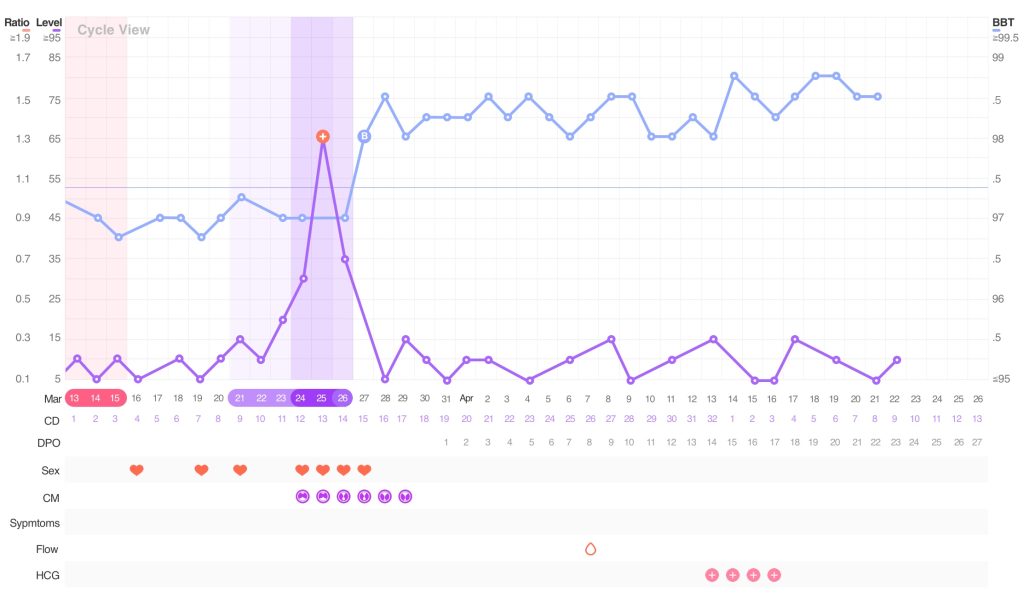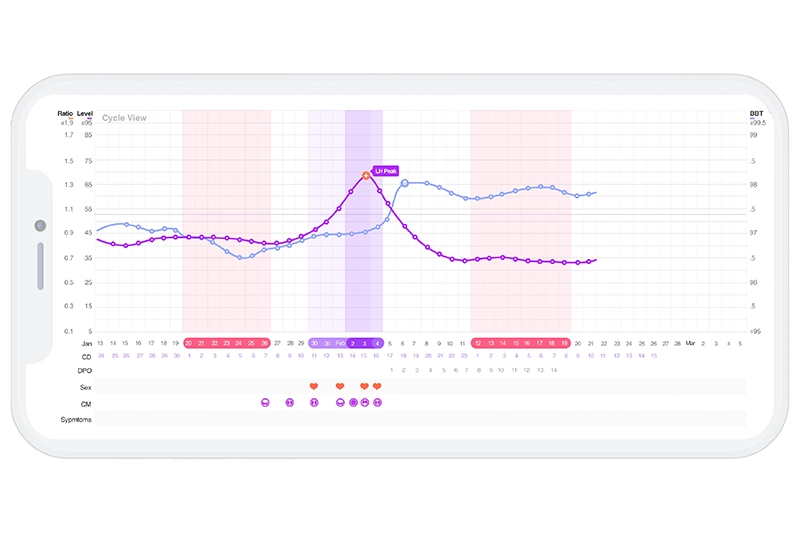When you first sit down to look at a Premom chart, it can look a bit overwhelming, but together we are going to discuss how each of the pieces fit together to provide you with your fertile picture! You’ll learn about ovulation tests, basal body temperature, cervical mucus, and timing intercourse.
For starters, it’s essential that you are tracking your symptoms each day — the more information you can record and the more consistent you are, the better the information you can glean from the chart.
Premom will help you track the following information throughout each cycle:
- Ovulation Tests
- Basal Body Temperature (BBT)
- Cervical Mucus
- Intercourse
- Symptoms you may have experienced
Before we take a look at some charts, let’s briefly discuss why each of these components is important when it comes to your fertility.
Ovulation Tests
The orange, red, or purple lines indicate ovulation tests on your Premom chart.
Ovulation tests measure your urine for something called Luteinizing Hormone (LH), which is secreted by your brain and triggers follicle maturation and the release of an egg from the ovary.
LH begins to rise over the course of a few days and finally peaks drastically about 24-36 hours before you actually ovulate. This is what makes this hormone a good indicator that ovulation is about to occur and allows you to time intercourse accordingly.
After the darkest strip, you will notice a decline (lightening) in LH levels. If LH strips are lighter and lighter 2 days in a row, you know that you’ve likely already ovulated, missed your ovulation, or perhaps did not ovulate this cycle. Use a confirmatory method along with your ovulation testing to confirm ovulation has successfully occurred.
Basal Body Temperature (BBT)
The blue line indicates BBT readings on your Premom chart.
A little science for you: progesterone is the hormone secreted by the ovaries (corpus luteum) AFTER an egg has been released. When progesterone levels increase, we can feel confident that you ovulated. Progesterone increases body temperature; we are looking for this increase in temperature as depicted in your chart to confirm ovulation. Your temperature will likely increase at least 0.2 degrees Fahrenheit (0.11 in Celsius) after ovulation, this is higher than the past 6 days.
Your temperature will also likely remain high throughout early pregnancy due to the presence of progesterone. If a pregnancy did not occur — or progesterone levels were insufficient — you will see it slowly trickle back down to baseline by the time your period begins.
Cervical Mucus (CM)
It may sound strange but, your vagina is like your nose! It creates mucoid secretions just like your nose does. This mucus can tell us a great deal about what is going on with your hormones. Cervical mucus is greatly affected by hormonal changes, and when we know what to look for, it can provide us information about our fertile window.
Cervical mucus ranges from dry, sticky, wet like a drop of water, and slippery like raw egg whites. ‘Clear, thin, slippery and stretchy mucus’ is what we are looking for to indicate ovulation is near! This is a great sign of fertility and indicates elevated estradiol levels prior to an LH surge, which means ovulation is likely a few days away!
Track your cervical mucus at least once each day and record in the Premom app. It’s easiest to check by taking a peek at your panties or taking a look at the toilet paper after wiping post-urination.
When you feel that slippery cervical mucus, it’s a great time to begin intercourse to ensure sperm are present before ovulation!
Now that we’ve got the basics down, let’s take a look at some charts!

A Common Ovulation Chart
The above chart illustrates a normal menstrual cycle which may vary between 21-35 days in length. Let’s look at a cycle divided into two phases: pre-ovulatory and post-ovulatory with ovulation in between the two phases.
Pre-ovulatory Phase (period and follicular phase)
Begins: The first day of full-flow red menstrual bleeding which is considered cycle day 1
Ends: At ovulation
Main Hormone: Estrogen is released from the ovary, which matures an egg to be released at ovulation
Begins: Typically within 24-36 hours after an LH peak
Ends: After the egg is released
Main Hormone: Luteinizing hormone
Post-ovulatory Phase (luteal phase)
Begins: After ovulation
Ends: A day before next period begins
BBT changes: typically rises around 0.5-1 degree F within 1-3 days after ovulation
Main Hormone: Progesterone is released from the corpus luteum within the ovary after ovulation and causes basal temperatures to rise
How Can I Tell If I Am Pregnant from My Chart
After ovulation, if an egg is fertilized it will move through the fallopian tube to the uterus and implant within the uterine wall. Implantation typically occurs around 6-10 days past ovulation (DPO). Once implantation occurs, the pregnancy hormone hCG rises and progesterone will remain elevated.

There are 3 potential signs of pregnancy you may notice from your fertility chart:
1) Temperatures remain elevated longer than your typical luteal phase. If your temperatures remain high for 16 or more days, it may be an indicator of pregnancy.
2) Implantation spotting or light bleeding may occur at the time of implantation as the baby burrows into the uterine wall.
3) You may have a second surge in LH during your luteal phase. Since the pregnancy hormone, hCG is chemically similar to LH, an LH strip may show a positive result.
How Do I Know If I’m Not Ovulating?
Anovulation is a term used when a woman does not ovulate during a menstrual cycle. It is normal for a woman to experience an occasional cycle in which she does not ovulate, due to illness or stress; however, a recurring pattern of non-ovulatory cycles is a concern. Charting your cycle can offer signs of whether ovulation is occurring.
3 potential signs of an ovulation based on charting:
1) Sporadic BBT patterns with no distinguishable rise in temperatures in the second half of the cycle.
2) No evident LH surge.
3) No noticeable fertile cervical mucus.
Putting It All Together in Your Premom Ovulation Chart!
Fertile Window
Through all of your diligent tracking and Premom’s smart technology, you can see your fertile window as evidenced by the purple area. It’s important to have intercourse within this timeline as it’s the only time you can get pregnant during your cycle.
Timing Intercourse
By having intercourse during your fertile window, it allows the sperm time to swim through the cervix, up to the top of the uterus so that they can be present for fertilization when an egg is released! So when you feel that slippery cervical mucus and notice your LH strips beginning to darken, it’s a great time to start baby dancing!
You may be noticing that you are considered fertile before you’ve even ovulated. This may be earlier than you had thought. However, sperm need to be present ahead of time in the uterus, as they can survive up to 5 days, while an egg may only live 24 hours.
A Few Things To Note
As you’ve discovered, the female menstrual cycle is quite complex, and things can get confusing when BBT and LH strips don’t seem to follow a typical pattern. Using period start and stop dates is a great place to start in predicting your fertile window, but it’s important to rely on your ovulation tests, cervical mucus changes, and BBT to confirm that ovulation is actually occurring. This is what makes Premom more advanced than other cycle tracker apps and gives you confidence in what is actually occurring in your body.
If you aren’t seeing a pattern in your testing, you’ll need to do some work to get your hormones cycling properly and investigate what the cause of your imbalance is. Could it be stress? PCOS? Over-exercising? Excessive alcohol consumption? Inflammation? Or just an anovulatory cycle?
It takes time to get to know your menstrual cycle, so the sooner you can begin tracking, the better. It often takes about 1-3 cycles to get accustomed to your cycle and uncover your fertility pattern.
References
- Godbert, Sonya, et al. “Comparison between the Different Methods Developed for Determining the Onset of the LH Surge in Urine during the Human Menstrual Cycle.” Archives of Gynecology and Obstetrics, vol. 292, no. 5, 2015, pp. 1153–1161., doi:10.1007/s00404-015-3732-z.
- Rosa M. Limiñana-Gras, et al. “Health and Gender Perspective in Infertility” The Psychology of Gender and Health, 2017, doi:10.1016/B978-0-12-803864-2.00014-6.
- Wilcox, Allen J., et al. “Timing of Sexual Intercourse in Relation to Ovulation — Effects on the Probability of Conception, Survival of the Pregnancy, and Sex of the Baby.” New England Journal of Medicine, vol. 333, no. 23, 1995, pp. 1517–1521., doi:10.1056/nejm199512073332301.



